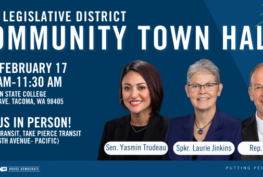After two years of relentless pandemic response, Washington state’s healthcare system needs significant support. Frontline providers have delivered unwavering care to our communities, and this session, the state has stepped up. The legislature supported our healthcare system by not only restoring but also strengthening important investments that will benefit us all, and the importance of this funding should not be overlooked.
Community health centers like our very own Community Health Care in Pierce County serve some of our most vulnerable neighbors. These are the same neighbors and friends that have been hit hardest by this pandemic. Health centers have been a consistent partner in our community-wide public health response, providing drive-through testing, vaccine education and outreach, and vaccination clinics, with a priority of reaching the most underserved populations in our communities. Their work has saved lives.
On top of conducting testing and vaccination events and caring for patients with Covid, health centers – like so many industries – had to pivot, transforming their models of care to include telehealth services to continue delivering quality behavioral health and primary care services.
These efforts protected our communities and reduced the impact on local hospitals but were not without cost. The pandemic gouged community health centers’ finances and resources, and our state’s payment models unintentionally penalized them. Rather than being rewarded for their extraordinary pandemic response, community health centers were facing huge payment shortages or being asked to return funding when metrics weren’t adjusted to reflect the crisis. This could have led to devastating impacts to our health care system, and it was critical that legislators figure out a path forward.
Taking this into consideration, the Senate led a bipartisan effort this legislative session to ensure financial stability for health centers, a critical injection to bolster these vital community assets. The final state budget also invests in workforce supports, such as increasing funding for the Washington Health Corp Loan Repayment Program to attract professionals to work in underserved communities.
The legislature also acknowledged the link between affordable housing and wellness and established a program that will provide housing benefits to individuals enrolled in Medicaid who have medical risk factors and face barriers to stable housing. Legislators also expanded health coverage to all uninsured adults under 138 percent of the federal poverty level, regardless of immigration status, and addressed dental care shortages for low-income patients by funding new community health dental clinics.
This funding works in lockstep with the suite of bills the legislature passed to make healthcare more affordable. This includes capping the cost of insulin at $35 (down from $100), protecting patients from huge out-of-network health care charges, and standardizing billing for subsidized care to expand free and reduced health care access to over 2 million Washingtonians.
These investments in health care are investments in community and equity, which will be cornerstones in our recovery and a strong future. We know that our community isn’t a healthy community unless we are all healthy – a commitment that has been at the heart of the community health center mission for decades. We must support this important work and provide for our neighbors by funding community health, not just this year but every year.




